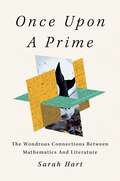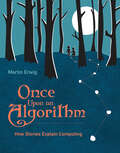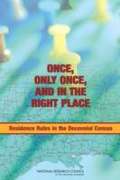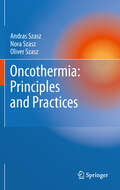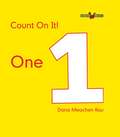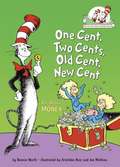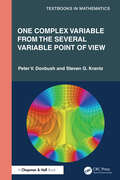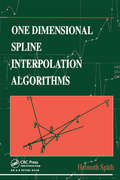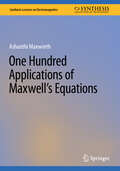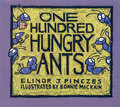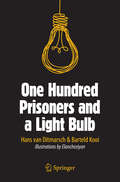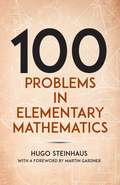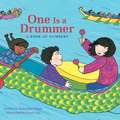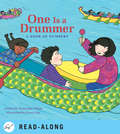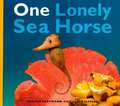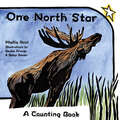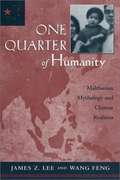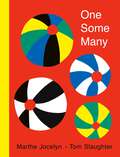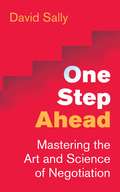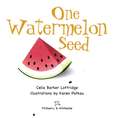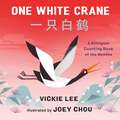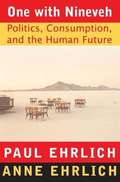- Table View
- List View
Once Upon a Prime: The Wondrous Connections Between Mathematics and Literature
by Sarah HartA New York Times Book Review Editors’ Choice “Wide-ranging and thoroughly winning.” —Jordan Ellenberg, The New York Times Book Review“An absolute joy to read!" —Steven Levitt, New York Times bestselling author of Freakonomics For fans of Seven Brief Lessons in Physics, an exploration of the many ways mathematics can transform our understanding of literature and vice versa, by the first woman to hold England's oldest mathematical chair.We often think of mathematics and literature as polar opposites. But what if, instead, they were fundamentally linked? In her clear, insightful, laugh-out-loud funny debut, Once Upon a Prime, Professor Sarah Hart shows us the myriad connections between math and literature, and how understanding those connections can enhance our enjoyment of both. Did you know, for instance, that Moby-Dick is full of sophisticated geometry? That James Joyce’s stream-of-consciousness novels are deliberately checkered with mathematical references? That George Eliot was obsessed with statistics? That Jurassic Park is undergirded by fractal patterns? That Sir Arthur Conan Doyle and Chimamanda Ngozi Adichie wrote mathematician characters? From sonnets to fairytales to experimental French literature, Professor Hart shows how math and literature are complementary parts of the same quest, to understand human life and our place in the universe. As the first woman to hold England’s oldest mathematical chair, Professor Hart is the ideal tour guide, taking us on an unforgettable journey through the books we thought we knew, revealing new layers of beauty and wonder. As she promises, you’re going to need a bigger bookcase.
Once Upon an Algorithm: How Stories Explain Computing (The\mit Press Ser.)
by Martin ErwigHow Hansel and Gretel, Sherlock Holmes, the movie Groundhog Day, Harry Potter, and other familiar stories illustrate the concepts of computing.Picture a computer scientist, staring at a screen and clicking away frantically on a keyboard, hacking into a system, or perhaps developing an app. Now delete that picture. In Once Upon an Algorithm, Martin Erwig explains computation as something that takes place beyond electronic computers, and computer science as the study of systematic problem solving. Erwig points out that many daily activities involve problem solving. Getting up in the morning, for example: You get up, take a shower, get dressed, eat breakfast. This simple daily routine solves a recurring problem through a series of well-defined steps. In computer science, such a routine is called an algorithm.Erwig illustrates a series of concepts in computing with examples from daily life and familiar stories. Hansel and Gretel, for example, execute an algorithm to get home from the forest. The movie Groundhog Day illustrates the problem of unsolvability; Sherlock Holmes manipulates data structures when solving a crime; the magic in Harry Potter's world is understood through types and abstraction; and Indiana Jones demonstrates the complexity of searching. Along the way, Erwig also discusses representations and different ways to organize data; “intractable” problems; language, syntax, and ambiguity; control structures, loops, and the halting problem; different forms of recursion; and rules for finding errors in algorithms.This engaging book explains computation accessibly and shows its relevance to daily life. Something to think about next time we execute the algorithm of getting up in the morning.
Once, Only Once, and in the Right Place: Residence Rules in the Decennial Census
by Panel on Residence Rules in the Decennial CensusThe usefulness of the U.S. decennial census depends critically on the accuracy with which individual people are counted in specific housing units, at precise geographic locations. The 2000 and other recent censuses have relied on a set of residence rules to craft instructions on the census questionnaire in order to guide respondents to identify their correct &#34usual residence.&#34 Determining the proper place to count such groups as college students, prisoners, and military personnel has always been complicated and controversial; major societal trends such as placement of children in shared custody arrangements and the prevalence of &#34snowbird&#34 and &#34sunbird&#34 populations who regularly move to favorable climates further make it difficult to specify ties to one household and one place. Once, Only Once, and in the Right Place reviews the evolution of current residence rules and the way residence concepts are presented to respondents. It proposes major changes to the basic approach of collecting residence information and suggests a program of research to improve the 2010 and future censuses.
Oncothermia: Principles and Practices
by Andras Szasz Nora Szasz Oliver SzaszOncothermia is the next generation medical innovation that delivers selective, controlled and deep energy for cancer treatment. The basic principles for oncothermia stem from oncological hyperthermia, the oldest approach to treating cancer. Nevertheless, hyperthermia has been wrought with significant controversy, mostly stemming from shortcomings of controlled energy delivery. Oncothermia has been able to overcome these insufficiencies and prove to be a controlled, safe and efficacious treatment option. This book is the first attempt to elucidate the theory and practice of oncothermia, based on rigorous mathematical and biophysical analysis, not centered on the temperature increase. It is supported by numerous in-vitro and in-vivo findings and twenty years of clinical experience. This book will help scientists, researchers and medical practitioners in understanding the scientific and conceptual underpinnings of oncothermia and will add another valuable tool in the fight against cancer. Professor Andras Szasz is the inventor of oncothermia and the Head of St Istvan University's Biotechnics Department in Hungary. He has published over 300 papers and lectured at various universities around the world. Dr. Oliver Szasz is the managing director of Oncotherm, the global manufacturer and distributor of medical devices for cancer treatment used in Europe & Asia since the late 1980s. Dr. Nora Szasz is currently a management consultant in healthcare for McKinsey & Co.
One (Bookworms Count on It!)
by Dana Meachen RauPublisher's summary: Identifies things that inherently come in ones and lists other examples. The simple and engaging text and photos of Count On It! accomplish two things at once: They teach children how to count as well as to read. The direct correspondence between image and text and consistent format make these books ideal for the beginning reader and mathematician.
One Cent, Two Cents, Old Cent, New Cent: All About Money
by Bonnie WorthTHE CAT IN the Hat puts to rest any notion that money grows on trees in this super simple look at numismatics, the study of money and its history. Beginning with the ancient practice of bartering, the Cat explains various forms of money used in different cultures, from shells, feathers, leather, and jade to metal ingots to coins (including the smallest—the BB-like Indian fanam—and the largest—the 8-foot-wide, ship-sinking limestone ones from the Islands of Yap!), to the current king of currency, paper. Also included is a look at banking, from the use of temples as the first banks to the concept of gaining or paying interest, and a step-by-step guide to minting coins. A fascinating introduction is bound to change young reader’s appreciation for change!
One Complex Variable from the Several Variable Point of View (Textbooks in Mathematics)
by Steven G. Krantz Peter V. DovbushTraditionally speaking, those who study the function theory of one complex variable spend little or no time thinking about several complex variables. Conversely, experts in the function theory of several complex variables do not consider one complex variable. One complex variable is the inspiration and testing ground for several complex variables, and several complex variables are the natural generalization of one complex variable.The authors’ thesis here is that these two subject areas have much in common. These subject areas can gain a lot by learning to communicate with each other. These two fields are logically connected, and each can be used to explain and put the other into context. This is the purpose of this book.The point of view and the methodology of the two subject areas are quite different. One complex variable is an aspect of traditional hard analysis. Several complex variables are more like algebraic geometry and differential equations, with some differential geometry thrown in. The authors intend to create a marriage of the function theory of one complex variable and the function theory of several complex variables, leading to a new and productive dialogue between the two disciplines.The hope is for this book to foster and develop this miscegenation in a manner that leads to new collaborations and developments. There is much fertile ground here, and this book aims to breathe new life into it.
One Dimensional Spline Interpolation Algorithms
by Helmuth SpäthTogether with its compagnion volume this book presents a practical introduction to computing spline functions, the fundamental tools for fitting curves and surfaces in computer-aided design (CAD) and computer graphics.
One Hundred Applications of Maxwell’s Equations (Synthesis Lectures on Electromagnetics)
by Ashanthi MaxworthMaxwell's equations explain the basics of electricity and magnetism. The four equations provide a mathematical model for electric, optical, and radio technologies. And yet, when learning electromagnetic field theory, it is easy to get lost in the complicated mathematics and ignore the applied aspects of it. The purpose of this book is to bridge the gap between theory and applications of Maxwell’s equations. This book introduces readers to the mathematics of Maxwell’s equations and their uses in both everyday applications such as power generation, electric motors, wireless communication, as well as in scientific research. Each chapter in the book starts with an introduction to a specific Maxwell’s equation followed by examples of ways in which the equation is used.
One Hundred Hungry Ants
by Elinor J. PinczesThis tale of ants parading toward a picnic is &“one of those rare gems capable of entertaining while it instructs&” (Middlesex News). One hundred hungry ants march off single file to sample a picnic, but when the going gets too slow, they divide into two rows of fifty, then four rows of twenty-five . . . until they take so long that the picnic is gone! &“The unexpected pairing of sophisticated art and light-hearted text lends this book particular distinction.&” —Publishers Weekly &“The illustrations . . . use a pleasing palette and energetic lines to depict ants with highly individual characters.&” —Horn Book
One Hundred Prisoners and a Light Bulb
by Hans Van Ditmarsch Barteld KooiA group of 100 prisoners, all together in the prison dining area, are told that they will be all put in isolation cells and then will be interrogated one by one in a room containing a light with an on/off switch. The prisoners may communicate with one another by toggling the light switch (and that is the only way in which they can communicate). The light is initially switched off. There is no fixed order of interrogation, or interval between interrogations, and the same prisoner may be interrogated again at any stage. When interrogated, a prisoner can either do nothing, or toggle the light switch, or announce that all prisoners have been interrogated. If that announcement is true, the prisoners will (all) be set free, but if it is false, they will all be executed. While still in the dining room, and before the prisoners go to their isolation cells (forever), can the prisoners agree on a protocol that will set them free? At first glance, this riddle may seem impossible to solve: how can all of the necessary information be transmitted by the prisoners using only a single light bulb? There is indeed a solution, however, and it can be found by reasoning about knowledge. This book provides a guided tour through eleven classic logic puzzles that are engaging and challenging and often surprising in their solutions. These riddles revolve around the characters' declarations of knowledge, ignorance, and the appearance that they are contradicting themselves in some way. Each chapter focuses on one puzzle, which the authors break down in order to guide the reader toward the solution. For general readers and students with little technical knowledge of mathematics, One Hundred Prisoners and a Light Bulb will be an accessible and fun introduction to epistemic logic. Additionally, more advanced students and their teachers will find it to be a valuable reference text for introductory course work and further study.
One Hundred Problems in Elementary Mathematics (Dover Books on Mathematics)
by Martin Gardner Hugo SteinhausBoth a challenge to mathematically inclined readers and a useful supplementary text for high school and college courses, One Hundred Problems in Elementary Mathematics presents an instructive, stimulating collection of problems. Many problems address such matters as numbers, equations, inequalities, points, polygons, circles, ellipses, space, polyhedra, and spheres. An equal number deal with more amusing or more practical subjects, such as a picnic ham, blood groups, rooks on a chessboard, and the doings of the ingenious Dr. Abracadabrus.Are the problems in this book really elementary? Perhaps not in the lay reader’s sense, for anyone who desires to solve these problems must know a fair amount of mathematics, up to calculus. Nevertheless, Professor Steinhaus has given complete, detailed solutions to every one of his 100 problems, and anyone who works through the solutions will painlessly learn an astonishing amount of mathematics. A final chapter provides a true test for the most proficient readers: 13 additional unsolved problems, including some for which the author himself does not know the solutions.
One Hundred Years of Gauge Theory: Past, Present and Future Perspectives (Fundamental Theories of Physics #199)
by Claus Kiefer Silvia De BianchiThis book presents a multidisciplinary guide to gauge theory and gravity, with chapters by the world’s leading theoretical physicists, mathematicians, historians and philosophers of science. The contributions from theoretical physics explore e.g. the consistency of the unification of gravitation and quantum theory, the underpinnings of experimental tests of gauge theory and its role in shedding light on the relationship between mathematics and physics. In turn, historians and philosophers of science assess the impact of Weyl’s view on the philosophy of science. Graduate students, lecturers and researchers in the fields of history of science, theoretical physics and philosophy of science will benefit from this book by learning about the role played by Weyl’s Raum-Zeit-Materie in shaping several modern research fields, and by gaining insights into the future prospects of gauge theory in both theoretical and experimental physics. Furthermore, the book facilitates interdisciplinary exchange and conceptual innovation in tackling fundamental questions about our deepest theories of physics. Chapter “Weyl’s Raum-Zeit-Materie and the Philosophy of Science” is available open access under a Creative Commons Attribution 4.0 International License via link.springer.com
One Is a Drummer
by Grace Lin Roseanne ThongThis lively ebook shows that the world around us is filled with things to count. Three are the dim sum carts filled with yummy treats, eight are the candles on a birthday cake, and ten are the bamboo stalks growing in a garden. Many of the featured objects are Asian in origin, but all are universal in appeal. With brilliantly colored illustrations, an ear-pleasing text and an informative glossary, this truly multicultural book will make counting a fun part of every child's day!
One Is a Drummer: A Book of Numbers (Multicultural Shapes And Colors Ser.)
by Grace Lin Roseanne ThongThis lively ebook shows that the world around us is filled with things to count. Three are the dim sum carts filled with yummy treats, eight are the candles on a birthday cake, and ten are the bamboo stalks growing in a garden. Many of the featured objects are Asian in origin, but all are universal in appeal. With brilliantly colored illustrations, an ear-pleasing text and an informative glossary, this truly multicultural book will make counting a fun part of every child's day! Plus, this is the fixed format version, which will look almost identical to the print version. Additionally for devices that support audio, this ebook includes a read-along setting.
One Lonely Sea Horse
by Saxton Freymann Joost ElffersOne lonely sea horse learns that she has a lot of friends--friends she can really "count" on to help.
One North Star: A Counting Book
by Phyllis RootFive toads hop, four brook trout swim, three elk graze, two loons call, and one beaver gnaws on a paper birch tree, all under one North Star. Through bog and marsh, along river and lake, across prairie and into the woods, children learn what lives where by counting the creatures on foot or in flight, swimming or perching in exquisite woodcut and watercolor illustrations created by Beckie Prange and Betsy Bowen in an artistic collaboration. For those looking for more about the pictured wildlife, Phyllis Root includes fascinating facts and information on the state&’s ecosystems and the plants and animals that make their homes there.
One Quarter of Humanity
by James Z. Lee Wang FengThis book presents evidence about historical and contemporary Chinese population behavior that overturns much of the received wisdom about the differences between China and the West first voiced by Malthus. Malthus described a China in which early and universal marriage ensured high fertility and therefore high mortality. He contrasted this with Western Europe, where marriage occurred late and was far from universal, resulting in lower fertility and higher demographic responsiveness to economic circumstances. The result in China was thought to be mass misery as part of the population teetered on the brink of a Malthusian precipice, whereas in the West conditions were less severe. In reality, James Lee and Wang Feng argue, there has been effective regulation of population growth in China through a variety of practices that depressed marital fertility to levels far below European standards, and through the widespread practices of infanticide and abortion. Moreover, in China, population behavior has long been primarily a consequence of collective intervention. This collective culture underlies four distinctive features of the Chinese demographic pattern--high rates of female infanticide, low rates of male marriage, low rates of marital fertility, and high rates of adoption--that Lee and Wang trace from 1700 to today. These and other distinctive features of the Chinese demographic and social system, they argue, led to a different demographic transition in China from the one that took place in the West.
One Some Many
by Marthe JocelynOne Some Many by Marthe Jocelyn and Tom Slaughter is an excellent early introduction to numbers and to the principles of modern art. It is the perfect companion to 1 2 3, a counting book with a difference. Slaughter’s bold, Matisse-inspired paper cuts illustrate basic artistic elements, including color, form, and line, while the playful and inventive text introduces the concepts of quantity that children find most puzzling (and that adults have the most difficulty explaining!). After all, how many is many? Some? A few?
One Step Ahead: Mastering the Art and Science of Negotiation
by David SallyThe world's best negotiators have moved beyond the conventional wisdom by utilising cutting-edge studies and real-world results. It's time you did too. For over twenty years, David Sally has been teaching the art of negotiation at leading business schools and to executives at top companies. Now, using insights from social psychology and game theory, he delivers the proven, clear, actionable advice you need to stay one step ahead. By studying great examples, from Machiavelli to Wall Street, Xi Jinping and Barack Obama, he explores how the game&’s masters navigate the field strategically, craftily, even emotionally. The best know every negotiation is different and that your tactics are, in part, determined by your opponent. One Step Ahead will make sure that you have what it takes to come out on top, no matter who you are facing across the table.
One Watermelon Seed
by Celia Barker LottridgeIn this deceptively simple counting book, Max and Josephine tend their garden while readers follow along, counting from one to ten as the garden is planted. Then readers can count in groups of tens as the garden is harvested, while they search through the pictures for the many small animals that are hiding throughout. A concise and clever text introduces color and rhythm, and the illustrations are bright and engaging, making this a perfect counting book for children aged four to seven.
One White Crane: A Bilingual Counting Book of the Months
by Vickie LeeOne white crane, two black bears . . .Simply told and beautifully rendered, this counting board book takes young readers through the months of the year. Each month focuses on a new animal, from seals in May to cicadas in September. Sweet, accessible text in English and Chinese pairs with eye-catching art for a wonderful repeat reading experience.
One With Nineveh: Politics, Environment, and the Human Future
by Paul R. Ehrlich Anne H. Ehrlich"Through lucid explanations, telling anecdotes, and incisive analyses, the eminent scientists Paul Ehrlich and Anne Ehrlich here spotlight the three elephants in our global living room--rising consumption, increasing world population, and unchecked political and economic inequity--that together are increasingly shaping today's politics, undermining the planet's ability to sustain us, and determining humankind's future. The result is a book that brilliantly puts today's policy debates in a larger context and makes a compelling case for the critical discussions that we should be having." (From the book jacket.)
One to Nine: The Inner Life of Numbers
by Andrew HodgesWhat Lynne Truss did for grammar in Eats, Shoots & Leaves, Andrew Hodges now does for mathematics. Andrew Hodges, one of Britain's leading biographers and mathematical writers, brings numbers to three-dimensional life in this delightful and illuminating volume, filled with illustrations, which makes even the most challenging math problems accessible to the layperson. Inspired by millennia of human attempts to figure things out, this pithy book, which tackles mathematical conundrums from the ancient Greeks to superstring theory, finds a new twist to everything from musical harmony to code breaking, from the chemistry of sunflowers to the mystery of magic squares. Starting with the puzzle of defining unity, and ending with the recurring nines of infinite decimals, Hodges tells a story that takes in quantum physics, cosmology, climate change, and the origin of the computer. Hodges has written a classic work, at once playful but satisfyingly instructional, which will be ideal for the math aficionado and the Sudoku addict as well as for the life of the party.
